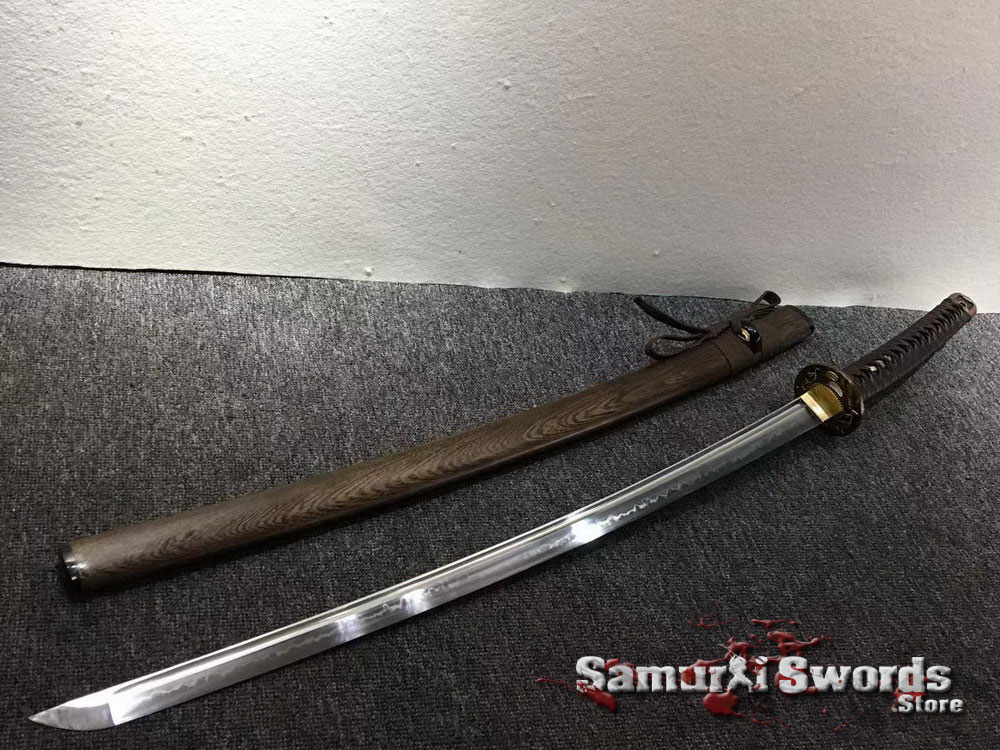Samurai Katana Blade T10 Clay Tempered Steel Choji Hamon
This is a Samurai Katana Blade made of T10 Clay Tempered Steel with Choji Hamon and Rosewood Saya With Buffalo Horn & High Quality Copper Fittings
Sword Type: Katana
Steel Type: T10 Clay Tempered Steel
Blade Length: 72 Centimeters
Handle Length: 27 Centimeters
Blade Width: 3.2 Centimeters
Weight: 1.73KG
Tang: Full Tang
Sharpness: Sharpened
Blood Groove: With Bohi (Blood Groove)
Tsuba (Handguard): High Quality Copper Tsuba
Fuchi (Hilt Collar): High Quality Copper Fuchi
Kashira (Pommel): High Quality Copper Kashira
Menuki (Handle Ornaments): High Quality Copper Menuki
Saya (Scabbard): Rosewood Saya With Buffalo Horn
Ito (Wrap): Authentic Brown Leather
Ray Skin (Samegawa): Black
Sword Bag: Silk
This is a full tang Katana that features a Bohi. It has a sharpened, fully functional blade that is great for Tameshigiri. It can withstand more abuse, and keep a sharper edge which makes it better for use.
The Full Tang and Strong Blade
This full tang Katana has its blade extending to almost the whole length of its Tsuka. It is something that makes the sword stronger and more resistant to the rigors of training. Full tang blades are also lighter, making them more comfortable for use in training.
The Katana is also lighter due to the presence of a Bohi. It is also referred to as the blood groove or fuller. This works by making the sword more lightweight and easier to wield. It generally alters the point of balance of the blade.
The Katana Steel
This sword has a blade made from T10 steel. It is sometimes referred to as High Speed Steel or Tool Steel since it’s an alloy made of Tungsten and Carbon Steel.
It has a high tenor of carbon unlike other carbon steel; plus, it also has a fraction of silicon content. Being clay tempered, this sword is able to keep a sharp edge while its spine is softer. This is to make it bend with ease when using it for practice. It can be achieved by the classic clay coating tempering method.
Katana Polish, Wrap, and Fittings
This Katana is also Hadori polished, where the Hamon is further improved. It is done via polishing of the blade using a coarse abrasive. The sword features a Choji hamon which is one of the oldest patterns around. This specific pattern is what the Ichimonji school is most known for.
For this Katana sword’s Tsuka, it is nicely wrapped with authentic brown leather. This material is strong and durable to have a tight hold on the Tsuka. It also comes with a black Samegawa to prevent your hands from getting sweaty when using the sword.
For the fittings, these include the Tsuba, Fuchi, Kashira, and Menuki all of which are pieces made from high quality copper.
All these fittings have useful functions for the sword. The Tsuba balances the sword while the Fuchi covers the opening on the Tsuka. For its Menuki, it is important due to the design and concept of the blade. Lastly, the Kashira also works for balance and to stop the handle from slipping from your hand.
Additions, Adornments, and Size
This Katana comes with a rosewood Saya with buffalo horn. It is a term that refers to a Japanese sword’s scabbard. The use of rosewood is great, since this material is durable and resistant. This sword also comes with a silk sword bag for added protection to the Katana.
For its measurements, this Katana weighs 1.73 kilograms. Its Tsuka is 27 centimeters long while the blade is 72 centimeters long and 3.2 centimeters wide.
When was the Katana Most Popular?
The Katana sword is a classic Nihonto used by the Samurai of feudal Japan. It is a vital weapon and part of the Daisho combination: the Katana and Wakizashi.
It was a popular weapon from 1400 AD until the year 1876. This was when the Samurai was soon abolished as one social class.

